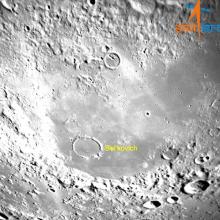Listen to today's episode of StarDate on the web the same day it airs in high-quality streaming audio without any extra ads or announcements. Choose a $8 one-month pass, or listen every day for a year for just $30.
You are here
Moon and Regulus
As the Sun sets, its lingering light creates a zone between daylight and darkness: the twilight zone. It typically lasts for about an hour, as Earth’s atmosphere scatters some sunlight back into the region where the Sun has already set.
There’s a twilight zone on the Moon, too, but it’s quite different from the one here on Earth. There’s a sharper boundary between day and night, with little sunlight reflected into the nightside.
The line between day and night is known as the terminator. It’s obvious as you watch the Moon descend the western sky this evening, with the bright star Regulus off to the left of the Moon. The terminator is bringing daylight, so more and more of the lunar disk will be illuminated over the next few days.
Here on Earth, the terminator moves at more than a thousand miles an hour at the equator. But the Moon is much smaller than Earth is, and it turns much more slowly. That combination means that a jogger could outrun the terminator, as it glides along at just 10 miles an hour.
There’s no atmosphere on the Moon to speak of, so the terminator is quite sharp. As it passes, it’s almost like someone flipped a light switch — it’s dark one second, and daylight the next.
But there is a bit of twilight. Radiation from the rising Sun can make tiny grains of dust float high into the sky. These grains form a glowing layer that reflects a little sunlight back into the nightside — giving the Moon a “twilight zone” of its own.
Script by Damond Benningfield






